31 October 1997
Half-Hour Ride in a T-6, with 15 minutes' stick time
Collected the T-6 (it's really a SNJ-5, the Navy version ) ride that
Carol and the boys gave me for Christmas last year. The T-6 "Texan"
is a World War II era plane that was used for transition training, so that
new pilots could go from Piper Cub-type basic trainers to fighters and
bombers without killing themselves too often. (Hm. How often
can one kill oneself?) This is what got me taking flying
lessons again--mainly when the T-6 owner and pilot, Mark Hutchins, mentioned
to me on the phone last month, when I was scheduling the flight, that it
might be worth learning to fly just for the discipline. Well, it's
a discipline, all right. Anyway, that made sense to me and
helped clarify my thinking.
So Carol, Chris and I drove to 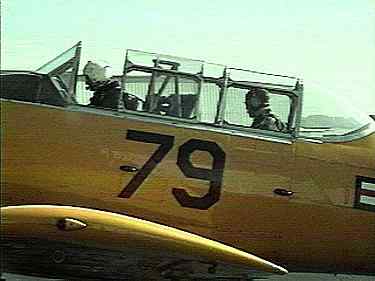 Winchester
Airport this morning, found the field and the T-6 and checked in at the
office. On the ramp, Hutchins's wife (a veterinarian who's also a
pilot) got me strapped in, first into the parachute harness and then into
the T-6's four-point seatbelt harness. She got me fixed up with a
WW II vintage flying helmet--cloth, though, not leather. I was surprised
by how comfortble it was, much more comfortable that a regular headset.
And of course it was good for the nostalgia, too. Reminded me of
the war surplus helmet I had as a kid. I was surprised at how much
space there was in the cockpit--in the back seat, at least. The belly
of the plane is about two feet below the rudder pedals, and there are two
platforms for the feet, rather than a solid floor. That's me in the
back seat. Hutchins' helmet has his name and date of birth (some
date in 1950) stenciled on the back and "Blood Type A Positive."
Probably puts the fear of god into many a passenger. He seems an
intelligent and thoughtful type, calm and quiet. Used to drive formula
race cars in Europe. Winchester
Airport this morning, found the field and the T-6 and checked in at the
office. On the ramp, Hutchins's wife (a veterinarian who's also a
pilot) got me strapped in, first into the parachute harness and then into
the T-6's four-point seatbelt harness. She got me fixed up with a
WW II vintage flying helmet--cloth, though, not leather. I was surprised
by how comfortble it was, much more comfortable that a regular headset.
And of course it was good for the nostalgia, too. Reminded me of
the war surplus helmet I had as a kid. I was surprised at how much
space there was in the cockpit--in the back seat, at least. The belly
of the plane is about two feet below the rudder pedals, and there are two
platforms for the feet, rather than a solid floor. That's me in the
back seat. Hutchins' helmet has his name and date of birth (some
date in 1950) stenciled on the back and "Blood Type A Positive."
Probably puts the fear of god into many a passenger. He seems an
intelligent and thoughtful type, calm and quiet. Used to drive formula
race cars in Europe. |
|
|
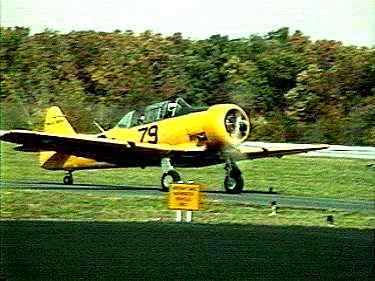 Then
he fired up the big radial engine--600 hp--and began taxiing to the end
of the runway, making S-turns so he could see ahead around the high nose. Then
he fired up the big radial engine--600 hp--and began taxiing to the end
of the runway, making S-turns so he could see ahead around the high nose. |
|
|
Take off was smooth and seemed easy, and soon we were climbing at about
80 knots and 1,000 feet per minute. At 2,500 feet--the airport is
at about 650 feet, I think--cruising at about 150 knots, 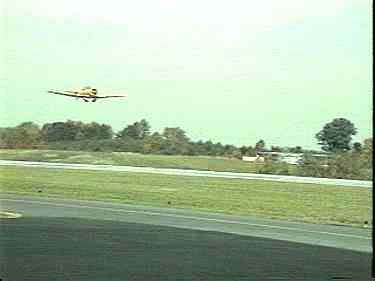 |
|
|
|
|
|
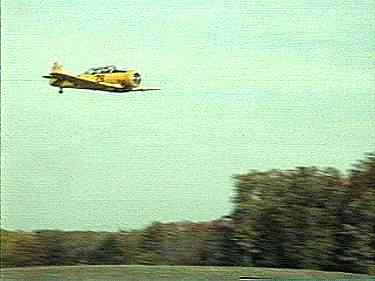
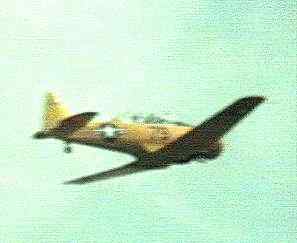 Hutchins
said for me to fly the plane and suggested that I try making some turns
to see how it flew. I was surprised to find that no real stick movement
was necessary at all, just a little bit of pressure and we rolled into
about a 15 degree turn. Well, I think it was 15 degrees; the
needle on the turn-and-bank indicator never budged once in the whole flight.
I mentioned that to Hutchins, but he said it wasn't needed in the back
seat. That was so--as long as he was flying in the front seat.
Anyway, I did a number of turns and found that it was easy to hold the
altitude. At his suggestion, I headed northeast toward a cut in the
mountain near Harper's Ferry There are two parallel ridges there, the Blue
Ridge and Short Hill Mountain (I looked them up on a topo map later), with
the Shenandoa River looping back and forth along the Blue Ridge and then
running eastward through the cut. The visibility was good, and the view
from a couple of thousand feet up was something.
Hutchins
said for me to fly the plane and suggested that I try making some turns
to see how it flew. I was surprised to find that no real stick movement
was necessary at all, just a little bit of pressure and we rolled into
about a 15 degree turn. Well, I think it was 15 degrees; the
needle on the turn-and-bank indicator never budged once in the whole flight.
I mentioned that to Hutchins, but he said it wasn't needed in the back
seat. That was so--as long as he was flying in the front seat.
Anyway, I did a number of turns and found that it was easy to hold the
altitude. At his suggestion, I headed northeast toward a cut in the
mountain near Harper's Ferry There are two parallel ridges there, the Blue
Ridge and Short Hill Mountain (I looked them up on a topo map later), with
the Shenandoa River looping back and forth along the Blue Ridge and then
running eastward through the cut. The visibility was good, and the view
from a couple of thousand feet up was something.
About 15 minutes into the half hour flight, we turned back toward Winchester.
A few minutes later Hutchins asked if I'd like for him to do a few aileron
rolls. I'd rather have gone on flying it myself, but he seemed eager
to perform, so I said yes. He took over and nosed down to accelerate
to about 180, then pulled up sharply--felt like about one G--and rolled
around. I think it's what used to be called a barrel roll, where
there's always positive gravity, even inverted, so you never feel yourself
hanging from your harness. He did several more rolls, the last a
four point roll that still didn't seem to produce any negative G force.
I guess those rolls are exciting to passsengers, yet don't induce them
to spread their lunches around the inside of the plane.
In landing, he held it off the runway until it quit flying ans settled
down softly on all three wheels. It was altogether a nice ride.
Expensive though. He's probably making a reasonable living at it,
despite the costs of maintenance, insureance, and all--and filling up the
fuel tanks. He said the T-6 cruises at 36 gallons per hour, so that's
70 bucks, or so, just for an hour's fuel..
There was enough time before his next scheduled flight to take Chris
up for fifteen minutes. Chris said he didn't want to try flying,
so Hutchins just went up fast and spent most of the time doing rolls, Immelmans,
and other such maneuvers. Chris came down with his breakfast still
in place and a big grin on his face.
On the drive home, we noticed the "Flying Circus" sign near Warrenton
and turned in just to have a look-see. What a difference from the
spic-and-span operations Winchester Airport, where the T-6 is, and from
the Chesterfield County Airport! The Flying Circus field is a meadow,
with trees all around and not a square foot of concrete or macadam in sight.
We drove around to the front of the long barn-like wooden hanger, where
we encountered Harold "Bo" Bogert, Jr. (as his card calls him), who was
working on the engine of the Fleet biplane they use in their weekly show.
He reminded me a lot of Carol's father. He showed us around and seemed
happy to talk airplanes for a while. In that hanger they have a Stearman,
an L-4, a J-3 Cub, and a couple of other biplanes I couldn't identify.
He gives rides for $60 a half hour and says he likes it best during the
week, when there's time for a really good ride. "Weekends," he said,
"it's just numbers."
Back to "Learning Flying"
My home page.
(I used a Snappy to grab the images from 8 mm video tape, then sharpened
and brightened them up a bit with PhotoImpact. Then I reduced them
to 25% of the original size and saved them with 35% jpeg compression.)
 Winchester
Airport this morning, found the field and the T-6 and checked in at the
office. On the ramp, Hutchins's wife (a veterinarian who's also a
pilot) got me strapped in, first into the parachute harness and then into
the T-6's four-point seatbelt harness. She got me fixed up with a
WW II vintage flying helmet--cloth, though, not leather. I was surprised
by how comfortble it was, much more comfortable that a regular headset.
And of course it was good for the nostalgia, too. Reminded me of
the war surplus helmet I had as a kid. I was surprised at how much
space there was in the cockpit--in the back seat, at least. The belly
of the plane is about two feet below the rudder pedals, and there are two
platforms for the feet, rather than a solid floor. That's me in the
back seat. Hutchins' helmet has his name and date of birth (some
date in 1950) stenciled on the back and "Blood Type A Positive."
Probably puts the fear of god into many a passenger. He seems an
intelligent and thoughtful type, calm and quiet. Used to drive formula
race cars in Europe.
Winchester
Airport this morning, found the field and the T-6 and checked in at the
office. On the ramp, Hutchins's wife (a veterinarian who's also a
pilot) got me strapped in, first into the parachute harness and then into
the T-6's four-point seatbelt harness. She got me fixed up with a
WW II vintage flying helmet--cloth, though, not leather. I was surprised
by how comfortble it was, much more comfortable that a regular headset.
And of course it was good for the nostalgia, too. Reminded me of
the war surplus helmet I had as a kid. I was surprised at how much
space there was in the cockpit--in the back seat, at least. The belly
of the plane is about two feet below the rudder pedals, and there are two
platforms for the feet, rather than a solid floor. That's me in the
back seat. Hutchins' helmet has his name and date of birth (some
date in 1950) stenciled on the back and "Blood Type A Positive."
Probably puts the fear of god into many a passenger. He seems an
intelligent and thoughtful type, calm and quiet. Used to drive formula
race cars in Europe.  Then
he fired up the big radial engine--600 hp--and began taxiing to the end
of the runway, making S-turns so he could see ahead around the high nose.
Then
he fired up the big radial engine--600 hp--and began taxiing to the end
of the runway, making S-turns so he could see ahead around the high nose.

 Hutchins
said for me to fly the plane and suggested that I try making some turns
to see how it flew. I was surprised to find that no real stick movement
was necessary at all, just a little bit of pressure and we rolled into
about a 15 degree turn. Well, I think it was 15 degrees; the
needle on the turn-and-bank indicator never budged once in the whole flight.
I mentioned that to Hutchins, but he said it wasn't needed in the back
seat. That was so--as long as he was flying in the front seat.
Anyway, I did a number of turns and found that it was easy to hold the
altitude. At his suggestion, I headed northeast toward a cut in the
mountain near Harper's Ferry There are two parallel ridges there, the Blue
Ridge and Short Hill Mountain (I looked them up on a topo map later), with
the Shenandoa River looping back and forth along the Blue Ridge and then
running eastward through the cut. The visibility was good, and the view
from a couple of thousand feet up was something.
Hutchins
said for me to fly the plane and suggested that I try making some turns
to see how it flew. I was surprised to find that no real stick movement
was necessary at all, just a little bit of pressure and we rolled into
about a 15 degree turn. Well, I think it was 15 degrees; the
needle on the turn-and-bank indicator never budged once in the whole flight.
I mentioned that to Hutchins, but he said it wasn't needed in the back
seat. That was so--as long as he was flying in the front seat.
Anyway, I did a number of turns and found that it was easy to hold the
altitude. At his suggestion, I headed northeast toward a cut in the
mountain near Harper's Ferry There are two parallel ridges there, the Blue
Ridge and Short Hill Mountain (I looked them up on a topo map later), with
the Shenandoa River looping back and forth along the Blue Ridge and then
running eastward through the cut. The visibility was good, and the view
from a couple of thousand feet up was something.